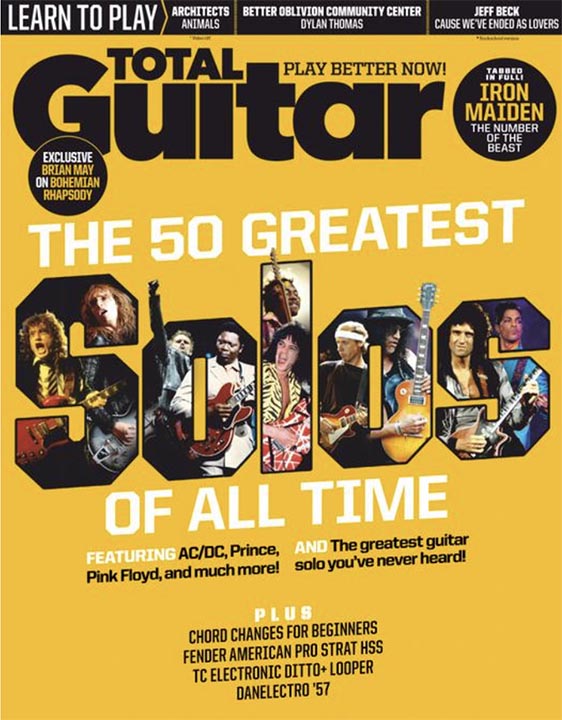From:
TOTAL GUITAR FEBRUARY 2021
COVER FEATURE

BOHEMIAN RHAPSODY QUEEN 1975
Interview: Chris Bird
The biggest rock song of all time?
Probably. And, we’d argue, a worthy winner of the TG greatest solos poll. Following Freddie Mercury’s death and after that cameo moment in Wayne’s World in 1992, Bohemian Rhapsody became a trigger point for a worldwide outpouring of affection and respect for Queen. Their renewed popularity would continue into the new millennium as Ben Elton’s We Will Rock You musical and the band’s discovery of a different way to exist behind frontman Adam Lambert would bring their music to a new generation. GUITARIST BRIAN MAY
And Bohemian Rhapsody? Well, unsurprisingly, it’s Queen’s best-known song, and its brief nine-bar solo is a short and sweet musical interlude, bridging the verses to lead into what’s become known as the ‘opera section’. Those two words alone should warn you that this song shouldn’t work. There’s no chorus. Aside from two verses, there’s no repetition. And there’s an opera section! But of course it does work, and Brian May’s solo is the perfect melodic break. His phrasing is loose and natural, moving across the backbeat rather than sticking to a rigidly-timed grid. The fastest licks are expressive bursts, rather than repetitive noodling. And Brian’s articulate pre-bend and vibrato technique demonstrates his beautiful touch.
Somehow, within the confines of the complex structure of Bohemian Rhapsody, this solo just works. Here, in TG’s exclusive interview, we catch up with our number one guitarist Brian May to talk about the writing process, and how he made the melody that was in his mind work in Mercury’s masterpiece…
EXTRACT:
TG: What do you remember about the recording of Bohemian Rhapsody and how you created the solo for it?
BRIAN MAY:
This track had been evolving for a while. It was very much the product of the fevered brow of Freddie. We knew it was something very special. It was recorded in pieces, as I think everybody knows. We would rehearse and record. We’d do it until we got it right. The various bits were put together. Freddie put a guide vocal on, and then we started doing all the multi-tracked vocal harmonies. There was already a rhythm guitar on there, of course. And somewhere during that process we talked about where there would be a solo, and that part of it Freddie hadn’t mapped out. He said he wanted a solo in there, and I said I would like to effectively sing a verse on the guitar. I would like to take it somewhere else. I would inject a different melody. There was already a lot of colour in there, but I would like to have a free hand. And I could hear something in my head at that point – long before I went in there and played it.
As you’re remembering this, can you picture you all in the studio?
It’s funny, because you see this in the Bohemian Rhapsody film. It’s quite faithfully reproduced, the way the Brian May character says, ‘Okay, how about this?’ And Freddie’s going, ‘Oh, lovely – but can you try a bit more of this?’
And the idea you had in your head – was that exactly how the solo came out?
Yeah. I basically sang it. I regard the guitar in that situation as a voice. I could hear this melody and I had no idea where it came from. That melody isn’t anywhere else in the song, but it’s on a familiar chord sequence, so it dovetails in quite nicely. And of course the job of the guitar solo is to bring that extra voice in, but then it’s a link into what everybody now calls ‘the operatic section’. You know you’re into something very different.
Did the solo require multiple takes?
It came out very easily. I didn’t do many takes. It was one of those occasions where you do a few takes and then you go back and listen to the first one and the first one is almost exactly what you want. You just need to trim it a little bit and polish it up.
And the climax of the song is very heavy on guitar.
The bit where everybody does the head-banging? That’s just riffing, and that was much more Freddie’s idea than mine. He had that riff in his head and I just played what he wanted there. I think he just sang it to me, what he wanted. We went for it live in the studio.
The different tones in that song, from the clean sounds in the solo to the distortion in the heavy part – how did that work?
It’s all about Vox AC30s and the treble booster – which was all inspired by Rory Gallagher. There’s really very little else on my guitar. There are no effects boxes as a rule. I used delays and stuff, but the fundamental tone that you hear is the guitar and the treble booster and the AC30. And the AC30 gives it that incredible throat, which is variable. The more you turn it up the more it goes into saturation. It doesn’t distort that much, and you’re still in the position at about nine and a half where you can still play chords and they still sound like chords. It doesn’t sound like a big fart [laughs]. So it’s a unique thing and we know why that is now, because the AC30 is fundamentally a class A amplifier, and because of the way the valves arecused, they’re biased half way up, they don’t distort until you drive them very, very hard, and then they go smoothly into that distortion. So that’s the whole thing. I get so used to that being the way that the guitar speaks, I take it for granted.
See more : Total Guitar Magazine February 2021 now on sale